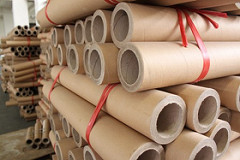
Paper is an important need in a man’s life. It is a necessity which he can never be away from. Being made with the trees was fine not until a few years ago. But, now preserving the environment has become the major concern of environmental activists.
So, then how do we make papers now taking into consideration that the trees are to be saved?
The paper can be made by the help of 3 means. They are:
- Chemical Pulping
- Mechanical Pulping
- Paper Recycling
- Chemical pulping:
Paper made from chemical pulping is also called wood-free papers.
Process:
It is a process which breaks down the chemical structure of lignin in order to make it soluble in the cooking liquor for the purpose of washing away its cellulose fibers. Non-fibrous constituent of wood, lignin keeps the cellulose fibers together and it is also responsible for reducing paper quality and permanence.
Break:
As lignin keeps the fibres together, this kind of pulping is important. It frees the fiber and even helps in making pulp. Bleaching of the pulp can even be done so as to make white paper which is utilized for printing, painting and writing.
Cost:
This kind of pulping mostly produces stronger paper when compared to other processes because it conserves fiber length. But, chemical pulps can be expensive because of its low yield i.e. 40-50% of the original wood.
The most common process for chemical pulping is sulfate process which evolved from the soda processes developed in the 19th Century.
The Kraft process is also an example of chemical pulping process that is practiced even today. It produces strong and unbleached papers which can be used directly for bags and boxes.
2. Mechanical pulping:
Usage:
Mechanical pulps are mainly used in newsprints, papers used in telephone directories, catalogs, “pulp” magazines, and paper towels and tissues.
It is a technique of converting logs or wood chips into paper pulp for use in papermaking accomplished by mechanical grinding. These pulps have very short fiber lengths because of which there is weaker paper produced.
Types:
Two types of mechanical pulps that are extensively used today are thermo mechanical pulp (TMP) and ground wood pulp (GW).
In the TMP process, the wood is fed into large steam-heated refiners once it has been chipped. It is then squeezed and fiberized between 2 steel discs. While Ground wood process utilizes debarked logs that are fed into grinders where they’re compressed against rotating stones, have its fibers free & then later on made to a pulp.
Facts:
The energy of this pulping is 1000KW/ton of pulp, the paper strength is low and production cost is lower.
3. Paper Recycling:
This type of process can make use of either mechanical or chemical pulp where hydrogen bonds in the paper are broken to take apart the fibers again with the use of water and applying mechanical action into the paper.
This type of paper is also called deinked pulp and fundamentally, it has the same quality or lower than the collected paper it was made from. Most recycled papers contain only some portion of virgin fiber in terms of quality.
Fact: According to the EPA, recycling a ton of paper can reduce greenhouse gas levels by a metric ton of carbon equivalent.
